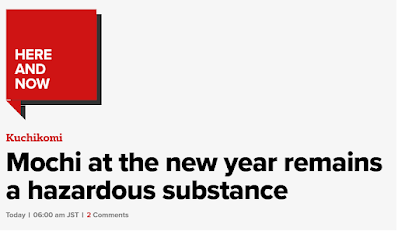During the first three days of 2022, a total of 19 people in the greater Tokyo area received emergency treatment for mochi lodged
in their throats, of whom four died. Once again confirming that mochi, a
food made from glutinous rice, traditionally consumed at the new year
and other celebratory occasions, can be a hazardous substance.
Broken down by age, 13 of the 19 receiving treatment were in their
80s, three in their 90s, and one each over age 100, in their 70s, and in
their 30s, respectively. All four fatalities involved people in their
80s.
One 82-year old man was reportedly saved when a family member
followed the instructions given over the telephone after they dialed the
119 emergency number.
As Nikkan Gendai (Dec 29) reports, two main factors can cause mochi
to become lodged in the throat. One is that many seniors have missing
teeth due to a variety of reasons, such as periodontal disease. What's
more with advancing age their tongues become weaker and with it, the
ability declines to transport chewed food to the throat. Moreover,
elderly people's salivary glands tend to produce less saliva, leading to
a decline in ability to swallow. If particles become lodged in the
windpipe they can choke.
"Likewise, as people age their ability to dislodge food particles
through reflex action weakens," said Dr Fujiki Ishihara, head of
Kita-Shinagawa Fuji Clinic.
"The second factor is the nature of mochi itself," Dr Ishihara
continues. "It is composed of alpha carbohydrates, but as the
temperature cools it changes to beta carbohydrates, which have a
different structure and are harder to digest. As the mochi's temperature
cools inside the mouth the risk of its blocking the windpipe
increases."
Problems can be avoided by breaking up mochi into smaller, more easily ingestible, pieces.
But Nikkan Gendai warns that consumption of mochi can also cause
problems for people of any age. For one thing, not chewing it thoroughly
before swallowing can result in its becoming impacted in the intestine.
"The problem occurs within one day of having consumed the mochi,"
Ishihara said. "It can not only block the intestine but also reduce the
flow of digestive juices, leading to abdominal bloating, constipation
and dehydration. In the worst cases it can cause serious dehydration or
abnormal generation of electrolytes. The body can go into shock with
loss of consciousness, and in extreme cases death can occur."
Neanwhile, another annoying impediment to new year's serenity has surfaced in the form of a report that many seasonal shimekazari decorations being sold in stores are not made in Japan.
A shimekazari is composed mostly of a shimenawa, a rope
woven from hemp fiber or rice straw that is used for ritual purification
in the Shinto religion. China has come to dominate the market for the
new year's ornaments many people attach to their doors during the
holiday period, this despite Shinto being a native Japanese religion.
In Yukan Fuji (Dec 29), Hidetoshi Tojo, representative director of the International Culture Promotional Association,
grumbles that a majority of the shimekazari sold in supermarkets and
convenience stores are woven from varieties of aquatic plants the
Chinese call shuicao (literally water grass).
Tojo, 50, isn't just any Tojo, but the great-grandson of General
Hideki Tojo, Japan's wartime prime minister from 1941 to 1944, who was
found guilty of war crimes by the Tokyo Tribunal and executed by hanging
in December 1948.
Tojo's allegations were confirmed by the unnamed president of a company that markets such decorations.
"Due to Japan's declining birth rate, these decorations have rapidly
lost their regional flavor. And the craftsmen who make them are aging
and dying out," he told Yukan Fuji.
As a result, he said, perhaps around 80% of the shimekazari now sold in Japan are imports from China.
Tojo, determined to adhere to the old traditions, has learned how to weave his own shimenawa from native Japanese straw.
"There's a difference between knowing the reasons behind a
traditional custom or ritual and not knowing at all," Tojo asserted. "I
even chose to study world history instead of Japanese history to avoid
being confronted with my great-grandfather's name. But over the past 10
years, I've finally come to terms with his reputation. As a result, I
now feel that to start making shimenawa on my own was a natural step."
© Japan Today





























